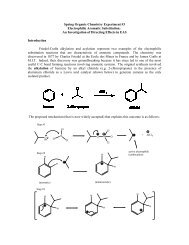Fall Organic Chemistry Experiment #2 (Recrystallization and Melting ...
Fall Organic Chemistry Experiment #2 (Recrystallization and Melting ...
Fall Organic Chemistry Experiment #2 (Recrystallization and Melting ...
- No tags were found...
You also want an ePaper? Increase the reach of your titles
YUMPU automatically turns print PDFs into web optimized ePapers that Google loves.
the may be dissolved in the solvent by washing with pure solvent. Keep in mind that wewill want to wash with COLD solvent so that we do not redissolve any of the crystals.(7) Drying the product.Normally we let the suction run for a few minutes to pass as much of the solvent throughto the filtrate as possible. Afterwards, we let the crystals air-dry for a sufficient period(24 hours) before performing further experiments or analyses (e.g. melting point).Be aware that you may run into problems. If such is the case <strong>and</strong> you are unable to acquirecrystalline material, do not give up. The process is really more art than it is science. You need tobe patient <strong>and</strong> seek out help if you get stuck or things do not work out as expected.Techniques:1. Crystallization2. Vacuum Filtration3. <strong>Melting</strong> PointsBefore Lab:Go the web address shown below <strong>and</strong> watch Video #9 (<strong>Recrystallization</strong>) <strong>and</strong> Video #12 (<strong>Melting</strong>Point Determination):http://ocw.mit.edu/ans7870/resources/chemvideo/index.htmProcedure:Obtain a sample of a solid unknown (approximately 2.5 g) <strong>and</strong> record the unknownnumber <strong>and</strong> mass in your laboratory notebook. Split the material into five "equal" portions.Record the mass of each sample <strong>and</strong> place each of the five solid fractions into five different 10 x75 mm test tubes. Label the tubes according to the type of solvent used to dissolve each sample(you may choose from water, methanol, hexanes, toluene, diethyl ether, ethyl acetate, ethanol,<strong>and</strong> acetone). I would suggest that you select a wide variety of solvents based upon theirpolarities. Attempt to dissolve each of the solid samples using approximately 2 mL of theappropriate solvent. Record your results (soluble or insoluble). If the solid is soluble, discard thecontents into the appropriate waste container in fume hood <strong>#2</strong>. For the insoluble ones, add aboiling chip <strong>and</strong> heat each to the boiling point in a boiling-water bath (boil 35-50 mL of water ina 150 mL beaker) or s<strong>and</strong> bath. Again record your results (soluble or insoluble). If the solidremains insoluble, discard the contents into the appropriate waste container in fume hood <strong>#2</strong>.Select one of the remaining solutions, perform a HOT gravity filtration to remove undissolvedimpurities. You may want to use a small funnel fitted with filter paper <strong>and</strong> a 50 mL Erlenmeyerflask to collect the filtrate. Allow these solutions to cool to room temperature <strong>and</strong> observewhether crystallization occurs or not. If crystals do not appear, try to induce it to occur. Collectthe crystals by vacuum filtration on a Hirsch funnel <strong>and</strong> wash the crystals with 1-2 mL of theCOLD recrystallization solvent. Allow the crystals to air dry until later in the week <strong>and</strong> then
obtain its mass <strong>and</strong> melting point (See Lehman OP-33, page 222-230 -- you'll be determiningmelting point by the Mel-Temp method). Determine the identity of your unknown according tothe table provided in Appendix VI (pgs. 341-355) of the Lehman text.
















